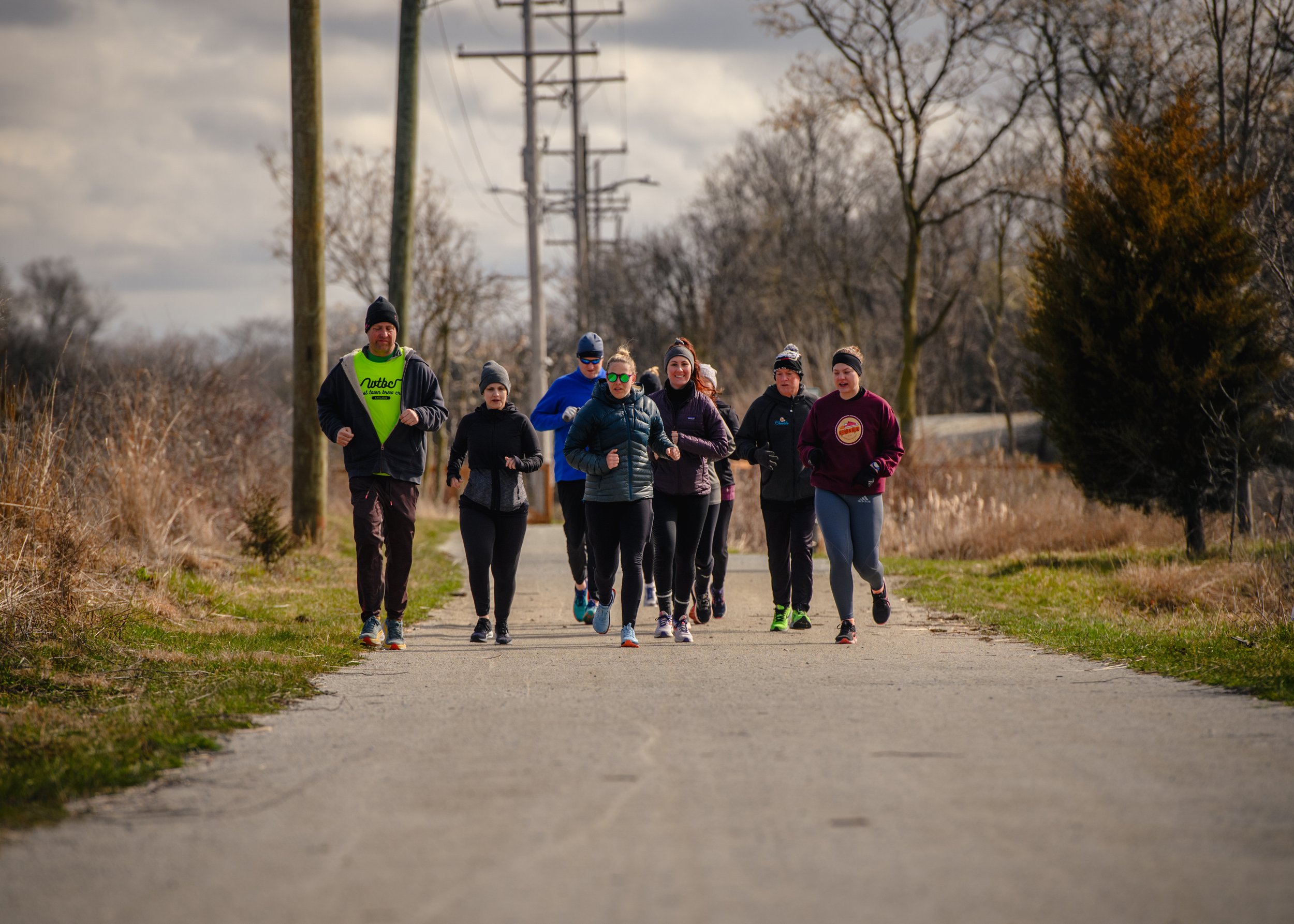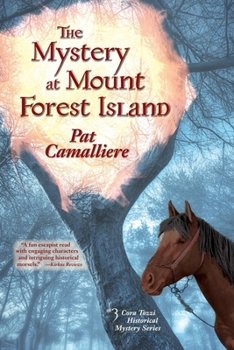Running Through Stories In Lemont
By Allison Yates
During our Winter 2024 and Summer 2024 season, Read & Run Chicago partnered with Lemont Downtown to host a series of in-person running tours inspired by local Lemont author Pat Camalliere’s Cora Tozzi Historical Mystery series.
In our three-part series, we brought three of the books in Pat’s series to life: The Mystery at Sag Bridge, The Mystery at Black Partridge Woods, and The Mystery at Mount Forest Island.
Each event included a running route corresponding to the local of the book inspiring that event, and Read & Run Chicago guide Carrie Mathews highlighted the novel’s real-life topics like Irish immigration, Illinois’s indigenous history, and even Chicago mob history. Following each running route, readers & runners headed back to downtown Lemont to enjoy the village’s delicious and welcoming locally-owned small businesses as we talked to author Pat Camalliere about her writing process, research, and journey to becoming an author.
Whether you weren’t able to join us for the series or just discovering Read & Run Chicago now, here’s where we ran, what we did, and how you can bring these stories to life. We’re made the routes available so whatever form of transportation you love—whether walking, running, rollerblading, cycling, or by wheelchair—you can use movement and stories to see Lemont from a different perspective.
The Mystery at Sag Bridge
Readers & runners gathered on March 23, 2024 outside of the Lemont Area Historical Society and Museum on a rather chilly spring morning to explore some of the fascinating historical sites in Lemont that the main character of Pat’s series, Cora Tozzi, frequents in The Mystery at Sag Bridge, including the Lemont train station, smokey row, and one of the oldest churches in town.
Cora is a very busy woman after retirement, hosting her book club, volunteering at the Lemont Historical Society, and serving on the Lemont Library Board. Cora’s simple life turns far from simple after an unexplained wolf attack, and we’re transported back to Lemont cerca 1898 through the eyes of a young Irish woman.
One of the locations where most of the plot takes place is St. James Church just outside of town. Unfortunately, the trails in this area were precarious and not safe for running. In lieu of hosting our event at this location, we provided this article written by Pat Camalliere and information on where to go after you read it.
Bring The Mystery of Sag Bridge to Life:
Photo credit: Brad Tammaro
The Lemont Area Historical Society is housed in the Old Stone Church, the oldest church structure in the village. It served as the Lemont Methodist Episcopal Church for 100 years, from 1861 to 1970. In 1970 the congregation moved and deeded the building to the Lemont Area Historical Society.
The building is made from Lemont stone tailings donated by a local quarry. Tailings are small irregular pieces of waste stone. The use of these tailings in its construction make the Old Stone Church different from any other building in town. It required careful work to lay an attractive and sturdy wall which was capable of weight bearing. The church was used as a recruiting depot during the Civil War and was also the site for reform activities, most notably by the Rev. J. Franklin Clancy, a Methodist minister who fought against liquor, gambling, prostitution and political corruption that took place in the notorious Smokey Row
Lemont Train Station
Carrie speaking to runners at the train station. Photo credit: Brad Tammaro
This station was built in 1859 as the railroads made their way north from Joliet toward Chicago. The railroad lines played a key role in transporting workers and shipping goods to and from the Chicago area. It's built of Joliet-Lemont limestone, also known as "Athens marble," bedrock that was encountered when the Illinois & Michigan Canal was being built in the 1830s and 40s.
I&M Canal
Runners along the Canal Path in Lemont. Photo credit: Brad Tammaro
Lemont's early history began in the late 1830s with the construction of the Illinois and Michigan Canal, and with the influx of immigrant workers who settled and remained. Towpaths were laid out along the sides of canals so that mules could pull barges the length of the canal. The average rate of travel was about three miles an hour, providing there was sufficient water in the canal and it wasn’t frozen. The canal didn't officially close until 1933 and now is primarily a source of recreation with this walking and biking trail and historic downtown communities sprinkled along each way.
Icebox Quarry
Runners in downtown Lemont. Photo credit: Brad Tammaro
The area called Icebox Quarry got its name from the refrigerator-size chunks ice harvesters would cut and haul into the streets of Lemont during the late 1800s and early 1900s. When canal digging revealed “Athens marble” at shallow depths below the valley's floor, Lemont became famous for its quarries. Swimming here on a hot summer day may feel amazing, but due to drowning deaths swimming is forbidden, except for triathletes, who can swim in one of the quarries as part of the gravel triathlon at the forge just east of Icebox Quarry!
Smokey Row
Runners passing Smokey Row Antiques in downtown Lemont, where you can pick up copies of Pat Camalliere’s books! Photo credit: Brad Tammaro
Before 1900 Lemont was notorious for its sin strip, "Smokey Row.” The construction of the canal brought an enormous amount of workers, mostly single men, to town. They didn't have a lot to do outside of their working hours and sought out amusement to distract them from their hardships. Smokey Row offered an abundance of places for gambling, liquor, drugs, and loose women, as well as bar fights and even illegal prizefights. It's estimated that at one time there were over 100 dives in operation in this section of town, making big money for the proprietors with one newspaper estimating about 60% of the $600K in wages going right into their hands. That’s about $13 million in today’s dollars going right to Smokey Row. A popular drink was the “Canal Tanglefoot,” which the Joliet News described as tasting like a compound of blue vitriol and gunpowder, one sip either sending a man on the warpath or rendering him unconscious.
The Mystery at Black Partridge Woods
On May 4, 2024, a humid early summer morning, readers & runners met at the Romeo Road entrance of the Centennial Trail, a beautiful path following the Des Plaines River, where much of this story takes place. In this novel, Wawetseka, a Potawatomi woman, is shocked when a body washes up near her village, but events soon turn worse: her only son is arrested for murder. To free him she must track down the real killer. Her investigation takes her through the wilderness of 1817 northern Illinois and to Fort Dearborn as she races desperately, fighting the harsh terrain and the realities of vigilante justice. Two centuries later, her descendent, Nick Pokagon, partners with Cora Tozzi, her husband Cisco, and their friend Frannie to publish Wawetseka’s adventures. But then Cora and her friends are attacked. The story asks these questions: What does Wawetseka’s story have to do with the present? How can the mysterious assailant be stopped?
As this story involves Native American history, we offered readers & runners additional resources to learn about Native American history and culture today.
Bring The Mystery at Black Partridge Woods to life:
The Highlights
As this story involves hidden treasure, guide Carrie Mathews entertained readers & runners with some other tales of famous hidden treasure. Here are some of the tales she shared:
Pirate treasure at Hawaii’s Palemano Point: Captain Thomas Cavendish was a 16th-century English privateer who may have buried some of his extensive silver and gold riches, worth about $5 million, at the Point. Modern-day explorers have tried to locate the hidden treasures or even the wreckage of his ship but so far both endeavors have failed.
Somewhere in Oklahoma—most likely somewhere in the Wichita Mountains—there is said to be over $1 million worth of hidden treasure left behind by Jesse James and his band of outlaws. There are hundreds of tales about their exploits, all ending with essentially the same words: “He left that treasure behind in the Wichitas, and it’s never been seen again.”
One of America’s most famous gangsters, John Dillinger, spent the spring of 1934 hiding at the Little Bohemia Lodge near Manitowish Waters, Wisconsin. FBI agents raided the lodge after a tipoff, but ended up in a shootout with Dillinger and his men. In the confusion, he apparently escaped out the back door with a suitcase containing $200,000 in small bills. Legend says that he buried the suitcase in the backyard of the Lodge. He was shot three months later in Chicago and the hidden treasures remain in Wisconsin to this day.
The Mystery at Mount Forest Island
On our third and final exploration of Lemont using movement and stories, readers & runners began their route at Sagawau Environmental Learning Center just east of downtown. The nearby Cal Sag gave readers & runners a few of Mount Forest Island, the special landscape Pat Camalliere decided to use as the setting for her novel.
This is a story about complex family relationships and how they can evolve over time. It’s also a story about friendship and forgiveness—and overcoming adversity and finding strength in a diverse community. And lucky for us, it had some big, juicy twists and turns along the way.
Bring The Mystery of Mount Forest Island to life:
The Highlights:
As this novel has a tie-in with the infamous Chicago Mob, Carrie gave some interesting facts about this group:
Unlike the Eastern United States, Chicago had no competition from nearby cities or other large criminal organizations. Territory was for all intents and purposes unlimited, and able to spread into communities, then suburbs, then other states. With the exception of casinos in Las Vegas and in the West, the Chicago Outfit controlled all mob activities west of Chicago across the United States.
In the early 1900s, Chicago’s consumption of alcohol was three times the national average. In 1927 Cicero was the “wettest” spot in the U.S., with Chicago Heights being number two.
Law enforcement routinely flew small planes over suspect areas in the winter, looking for roofs with no snow, as snow would melt if alcohol was being cooked. In Chicago Heights the mobsters painted their roofs white.
It is rumored that between Prohibition and the 1990s the mob had so much cash overflow that it’s likely that to this day undiscovered stashes are buried all over Chicagoland.
















